 |
You are here: Info » resources » articles » bird-photography
Photography in general has been my hobby for the past 14 years. But photographing Birds and Wildlife has been my passion for the last 3 years. The following article is a primer for those who are interested in Bird Photography or for seasoned photographers who want to enter the beautiful world of Bird Photography. The material is divided into progressive categories based on my experience in the field, having discussions with fellow bird photographers and with some help from the internet.
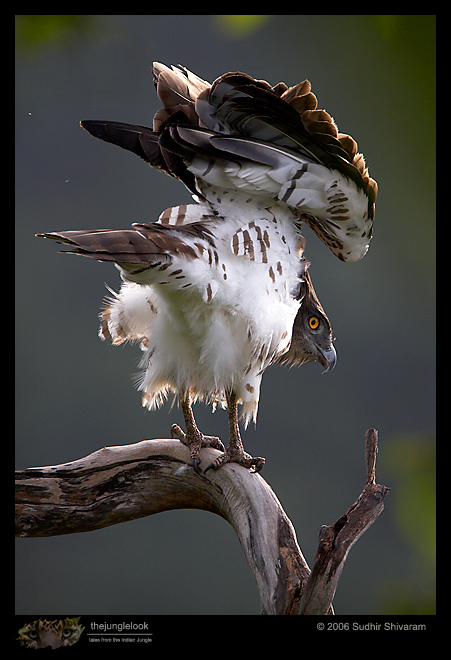
1. Introduction to the Birds of the Indian Subcontinent
About 1,250 species of birds have been recorded in the Indian Sub-Continent, including India, Pakistan, Bangladesh, Sri Lanka, Nepal and Bhutan. Many of these birds are winter visitors to our country and can be seen only during those specific months. There are other categories of birds which are endemic to a particular region and also those which are in the endangered list. The distribution of these birds can be grouped by habitat, climate conditions, etc.
2. Choosing and using the right equipment
It’s very important that you have the right set of equipment for Bird Photography. My advice to all the people who mail and ask me about the equipment to buy for bird photography is, always buy the best you can afford. The Digital Cameras, especially the DSLR’s are making a strong impression as of late. I moved from film SLR to DSLR mainly because of the quality of image and the cumbersome effort needed to get the film/slide processed and scanned. Not that you cannot get good quality images from film SLR. But it’s an individual choice. Now let’s see what kind of camera and lens you need for Bird Photography.
Camera:
Most of the bird photographers use 35mm SLR/DSLR bodies because of their cost, ease of use and the speed of operation they provide. Depending on your budget, I would advice you to go in for a decent entry level or mid range SLR/DSLR and keep those extra rupees to invest on lens, because that’s where the quality of your image depends. Some of the features in the camera I consider a necessity for bird photography is:
1. Changeable lens option
Do not go in for an aim and shoot camera. Even though there are digital cameras which have 10x optical zoom (reach of 400+ mm focal length), they are not good for bird photography. You need a camera where you have the flexibility to interchange lenses.
2. TTL metering and Exposure Modes
All the modern SLR/DSLR cameras offer TTL (Through The Lens) metering capabilities. Make sure your camera has this feature. Another useful feature in conjunction with the TTL is the availability of different automatic exposure modes i.e Aperture Priority, Shutter Priority and Program mode. For bird photography, it’s very important to have good shutter speed. Depending on the situation, you may have to work quickly changing between these exposure modes and taking advantage of the TTL metering.
3. Manual Exposure
This is a very useful exposure mode and is widely used by many professionals who normally use light meters. Using this mode you can override the camera settings and use your own aperture and shutter speed.
4. Exposure Compensation Dial
The exposure suggested by the camera may not be correct all the time. Or you may want to under expose or over expose your subject depending on the situation. This is where the exposure compensation dial come in. If your camera has suggested a meter reading of 1/250 sec for f8 aperture, and in case you want to under expose the image by a stop, you can use the exposure compensation dial to change the exposure settings.
5. Shooting modes
You have continuous mode, single frame and Self Timer modes. Each of these has its own advantages for bird photography. I normally keep my camera in continuous mode as you never know when you come across some action in nature. 6. Auto focus
The ability of the AF cameras to track the moving subjects and attain accurate focus is a boon for action photography in case of birds flying, running, swimming or any type of fast/slow movements.
7. Cropping factor for DSLRs
I would go in for a DSLR which has 1.3, 1.5 or a 1.6 cropping factor. Depending on the tele lens you use, the effective focal length gets magnified by the cropping factor and you get a longer reach. In case you have 1.6x cropping factor and are using a 400mm lens, you get a FOV (Field of View) of 640mm. This cropping factor is mainly due to the sensor size.
Lens
This is a difficult topic. There is no single lens suitable for bird photography. Serious bird photographers have a varied collection of lenses for composing the images they have in mind. Let’s look at the different options we have:
Wide Angle lens (50mm and below)
This lens is just not enough to do bird photography. But it does not mean they cannot be used at all. You can shoot Bird-Scapes or a huge flock of birds flying across the sky. There are situations where these lenses are very useful for doing remote photography.
Telephoto Lens (80mm to 300mm)
I have come across many beginners who start bird photography with their 75-300 zoom lens and get frustrated at the pics as the bird is a tiny spec in the photograph. But the digital SLR’s have an advantage. Most of the DSLRs have a cropping factor associated with the camera because of the sensor size. This effective focal length of the lens gets multiplied by the cropping factor and they have a longer reach with the lens. So a 300mm lens effectively becomes 480mm on a camera with 1.6 cropping factor.
But there are photographers who use a 300mm prime lens, either a f2.8 or a f4 lens and combine with a 1.4x or a 2x Tele Converters (devices used to increase the effective focal length of the lens). These are good combinations to get decent images in case of hand hold shooting.
Long Telephoto Lens (400mm and 500mm)
Now we are talking about bird photography lenses. Most of the professionals and serious photographers use either a 400mm or a 500mm lens coupled with a 1.4x or a 2x converter. It offers lovely, soft out of focus background and makes the image pop up. The 400mm range lens (except the f2.8 lens) is light enough to do hand held photography and are preferred by many to shoot birds in flight. To use a 500mm lens you need a sturdy tripod and a good head. Photographers over the world normally use a Gitzo tripod with a ball head or a Gimbal head. The combination of a camera + 500mm lens + TC + tripod would weight anywhere between 5-10 Kgs.
Super Telephoto Lens (600mm - 800mm)
These are the costliest of the lens. Along with the cost, they have their own disadvantages. They are heavy and are not easy to carry around in the field. You need a sturdy tripod to handle this. You do get the carbon fiber tripods from Gitzo which are light. But again, they are extremely costly. They cannot focus on nearby birds without the use of extension tubes. In spite of all these and other disadvantages they are awesome equipments for bird photographers. You can shoot the birds from a distance without disturbing them and yet get close-up images.
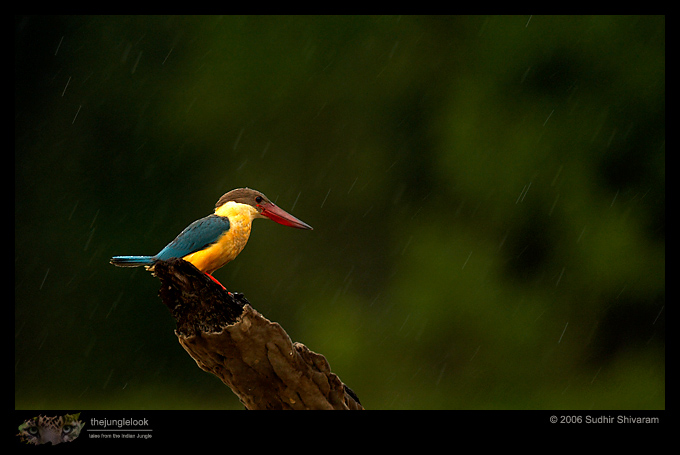
3. Know your Subject Well
If you look at the many top bird photographers, apart from the good technique they follow, they all have one thing in common. They are very knowledgeable on the birds they shoot. It’s very important to understand the bird’s behavior, their habitat and the timing and pattern of their migration.
Occasionally someone looks at one of my images and says, “Well, you were lucky to have gotten that close,” or “You were lucky to get that pose.” I smile and agree. Luck, good or bad, often does factor in. But spending countless hours in the field after endlessly studying habitat, behavior, and biology outweighs luck. I believe “chance favors the prepared mind.”
4. Getting close to Birds
Now comes the tough part. Most of the beginners who shoot birds often end up saying; the bird looks so small in my entire frame. Looking at my images they often ask me. Is your image heavily cropped? How do you manage to get so close to the birds? There are different techniques used to approach the birds at close range depending on the habitat and the location of the birds. Let’s take these one at a time.
Shooting from your vehicle
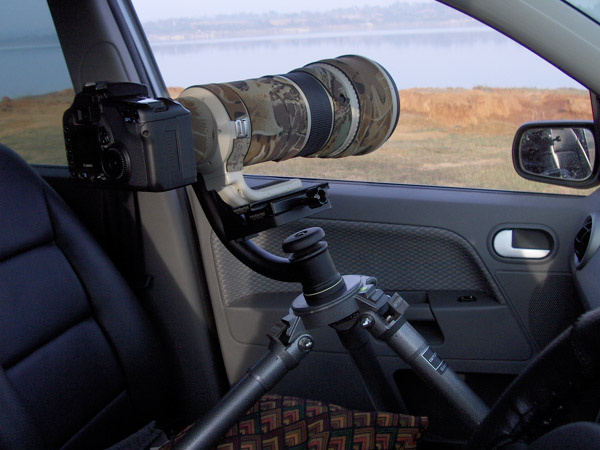 The tripod mounted camera is fixed in the passenger’s seat beside me
The tripod mounted camera is fixed in the passenger’s seat beside me
Here’s another view from outside 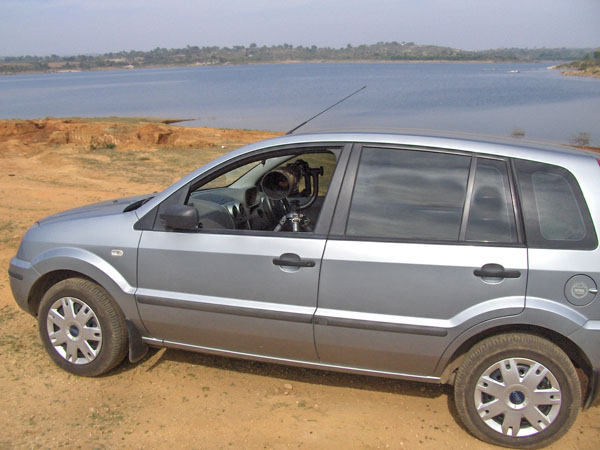
Approaching the Birds slowly
This needs lots of patience and practice, but is simple if you get hold of it.
Lying low approach
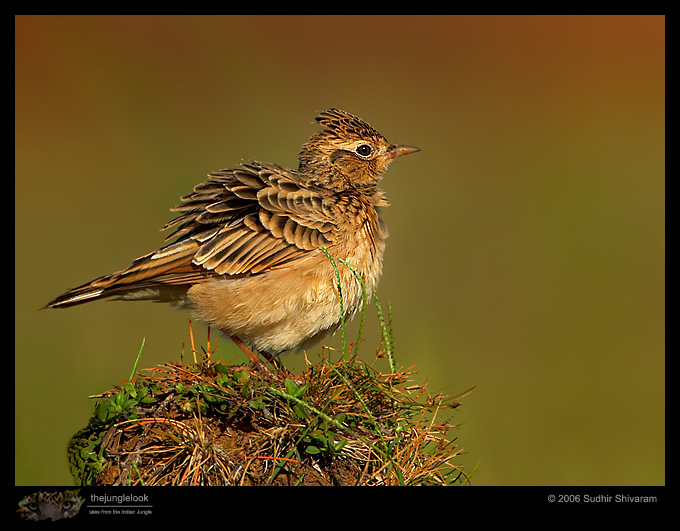 This image was made lying flat on the ground waiting for it to climb this small perch
This image was made lying flat on the ground waiting for it to climb this small perch
The slow approach works best for perched birds either in open or in wooded areas. But shooting shore birds or ground birds requires a different technique. It’s always advisable to shoot birds at eye level.
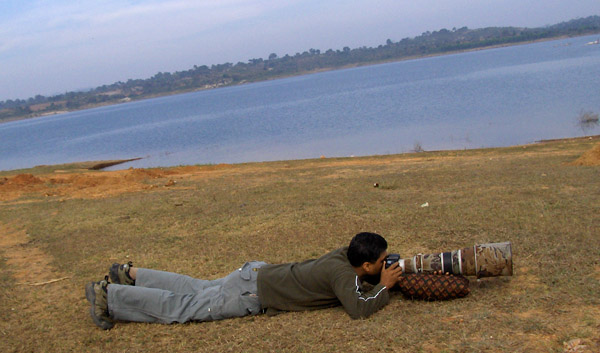 Shooting the Pipits and Wagtails using my bean bag and lying flat on the ground
Shooting the Pipits and Wagtails using my bean bag and lying flat on the ground
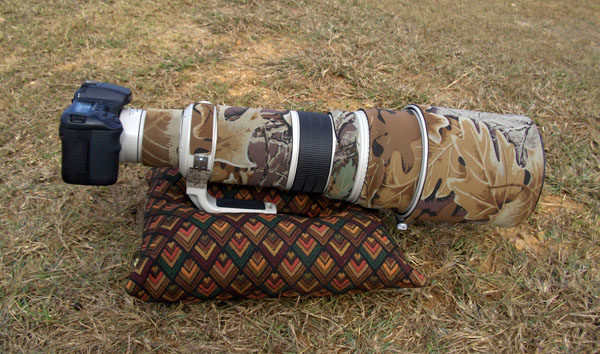 Here’s a close-up of my equipment on the my home made bean bag
Here’s a close-up of my equipment on the my home made bean bag
Here are some tips:
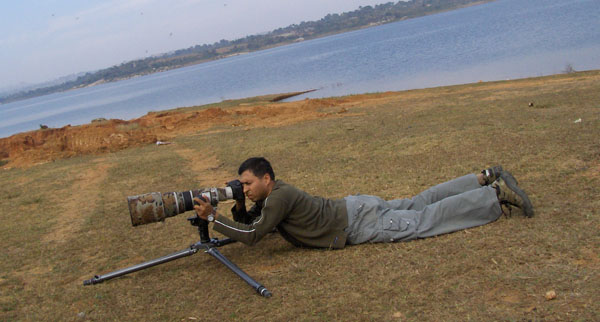 Low level photography using the tripod
Low level photography using the tripod
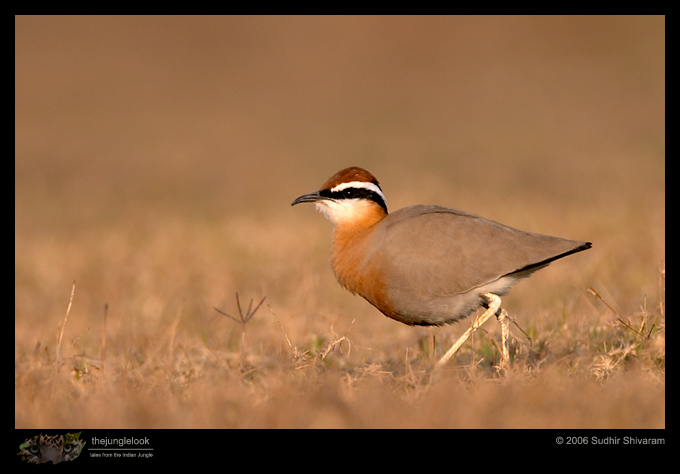 Indian Courser - Took this image by lying flat on the ground
Indian Courser - Took this image by lying flat on the ground
Shooting from Hide/Blinds
This is the most effective way to get pleasing images with proper composition and background. It if often impossible to shoot some category of birds with the different approaches I have mentioned above. This is most often used for shy birds. You have to do some homework for this.
5. Lighting Conditions
The other important factor in bird photography is the proper use of lighting.
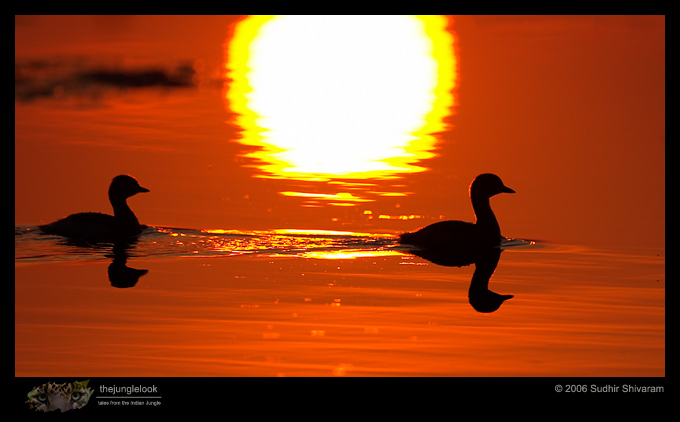 Little Grebe at Sunset - You can create magical images by making proper use of light
Little Grebe at Sunset - You can create magical images by making proper use of light
6. Exposure Techniques
You may have the world’s best equipment, but without understanding the basics of exposure, your chances of getting a good photograph are limited. An explanation on the basics of exposure is not in the scope of this document. There are materials available on the internet and books available to understand it. I suggest you refer to those materials. However, I would like to provide some useful tips in different situations for exposing your subject properly.
The below tips are for spot metering technique:
The below tips are for Center-Weighted technique:
Whether you spot meter the subject or use Center-Weighted technique, the idea is to place your subject at the tonality you want it to be.
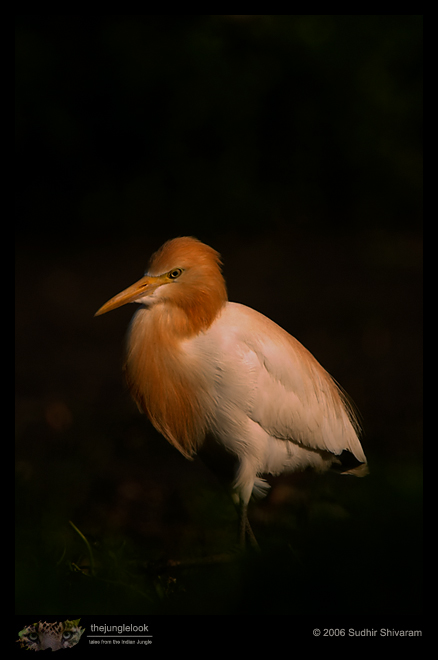
7. Image Composition and shooting
Composition is the art of clearly presenting your creative vision in an appealing manner. One of the most basic composition decisions is whether the picture frame should have vertical or a horizontal orientation. Once you have chosen a subject to photograph and decided whether to take vertical or horizontal picture, you have two other major decisions to make. First, how tightly or loosely should you frame your subject? And then, where within your rectangle image frame do you locate your subject.
Composition Tips
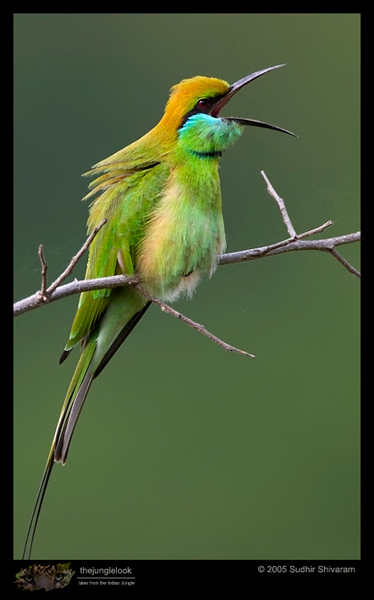 Green Bee-Eater - A Classic shot, but bad composition. Find the mistake
Green Bee-Eater - A Classic shot, but bad composition. Find the mistake
Shooting Tips
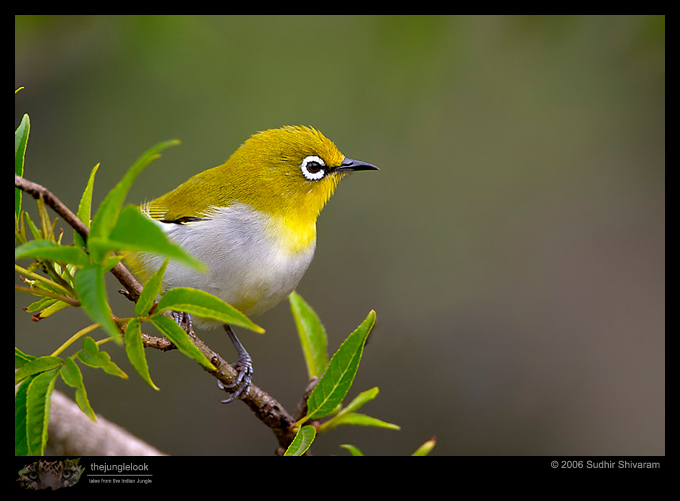
8. Making use of technology
From an era where we had to wait for the slides to be processed and developed for us to view the results, we have moved into a time where we can preview the images immediately in the field after taking the shot. The advantage of the digital cameras in the field of bird photography has tremendously helped in taking better images. The histogram displayed along with the image helps in deciding on the exposure of the image. Looking at the histogram, I decide if the exposure is correct or I need to do some compensation. I zoom in the preview to check the sharpness of the image and if satisfied, I move on to shoot the next subject.
The lens is the next important factor associated with technology. I swear by the Canon IS (Image Stabilization) technology, which is same as the VR (Vibration Reduction) in Nikon. It is supposed to give you around 3 stops of shutter speed. i.e., if you are shooting at 1/30 sec, then it is as if you are shooting at 1/120 sec. That’s a major advantage for low light / shutter photography. Also, you can hand hold some of the heavy lens and shoot momentarily if you have IS enabled. I have done it a lot of time using my Canon 500mm EF f/4L IS lens and got acceptably sharp images.
Next comes the camera bodies which have the different focusing modes – One shot, AI Servo and AI Focus (Canon terminologies, please check Nikon Manual for equivalent). One shot is for static subjects (sitting birds), AI Servo is for moving subjects (birds in flight) and AI Focus is for static subjects which may start to move (a sitting bird which may take-off). AI Focus is most useful for birds in flight. You need to enable all the focusing points in your camera and put the mode to AI Focus. You will have better chances of shooting birds in flight in this mode.
The higher Mega pixels DSLRs are the next boon for bird photographers. A minimum of 6MP is good for bird photography. In case of scanned slides, it is difficult to get good quality images if you close crop the image to more than 30%. But in case of images got from 6+MP DSLR’s, you can crop 80% of the frame and still get decent results. Many of the images on my website are cropped images for magnification. You can even compose the images while cropping, for better presentation. With a 6MP digital camera, you can easily print good quality images of up to 20×30 inches (full frame images).
The 1.3, 1.5 or the 1.6 cropping factor in DSLR’s is an important factor in case of Bird photography. My Canon 10D has a cropping factor of 1.6x. That means, a 500mm lens mounted on my 10D camera becomes an 800mm lens. So, when I add a 1.4x TC, I get an equivalent of around 1200mm. That’s pretty good for Bird photography. We require a minimum of 600mm focal length to shoot birds. But because of digital era, your 400mm becomes a 640mm and to add to that, you get decent images with around 50% crop. So logically speaking, you can get a full frame 1200mm image from your 400mm lens
The RAW format provided by the advanced Digital cameras is my pick in the technology section. People who always shoot RAW know its power. It’s called as the Digital Negative. You can change the white Balance, image temperature setting, colour balance, gain + or - 2 stops of light and a whole lot of other things without losing image quality. And all these after you have shot the image. RAW format is a data file compared to jpeg or tiff which is image file. When you make modifications to a RAW file, you are actually changing the pixel value in the data file which can be changed back to its original value. There are a lot of RAW processing software such as C1, Photoshop (which has RAW plug-in), Canon’s DPP, Nikon Capture etc. I always shoot in RAW format and have my own Digital Workflow to get the final image.
Ok, now that we have shot great images using all the above mentioned technologies, how do we actually present it to the viewer? That’s where the image editing software’s comes into picture. You have Photoshop, Gimp, Irfanview and a whole lot of image editing software available in the market. The Photoshop’s Unsharp Mask (for sharpening the image) is a major advantage in image processing. This improves the sharpness of the image to a considerable amount compared to what you got from the camera.
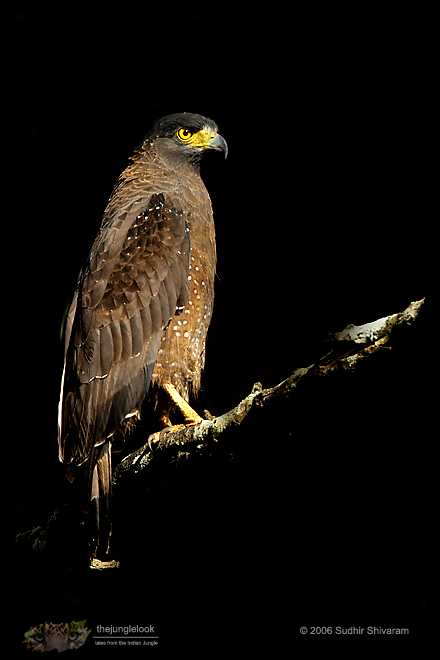 I made good use of the spotlight caused by the ray of sunlight falling on the Serpent Eagle. Then using postprocessing tools, cloned out unwanted branches around the eagle.
I made good use of the spotlight caused by the ray of sunlight falling on the Serpent Eagle. Then using postprocessing tools, cloned out unwanted branches around the eagle.
9. Do’s and Don’ts in Bird Photography
10. Finally the 3 P’s
Though it’s easy to put down on paper on how to do bird photography, its not as straight forward as it sounds. I have spent countless hours in the field trying to get that image I have framed in my mind and many times returned unsuccessful. I have waded through water, walked through slush, crawled on the open ground, lied flat on the ground for hours, climbed tress, ran across thorny shrubs, carried my 10kg equipment for the whole day in the field and a lot more stuff – just to get that one image. You really need to put in that hard work. And when I look at the image I have got after struggling so much, I feel it was worth it. Hence in bird photography, I have always believed in the 3 P’s – Patience and Perseverance always Pays.